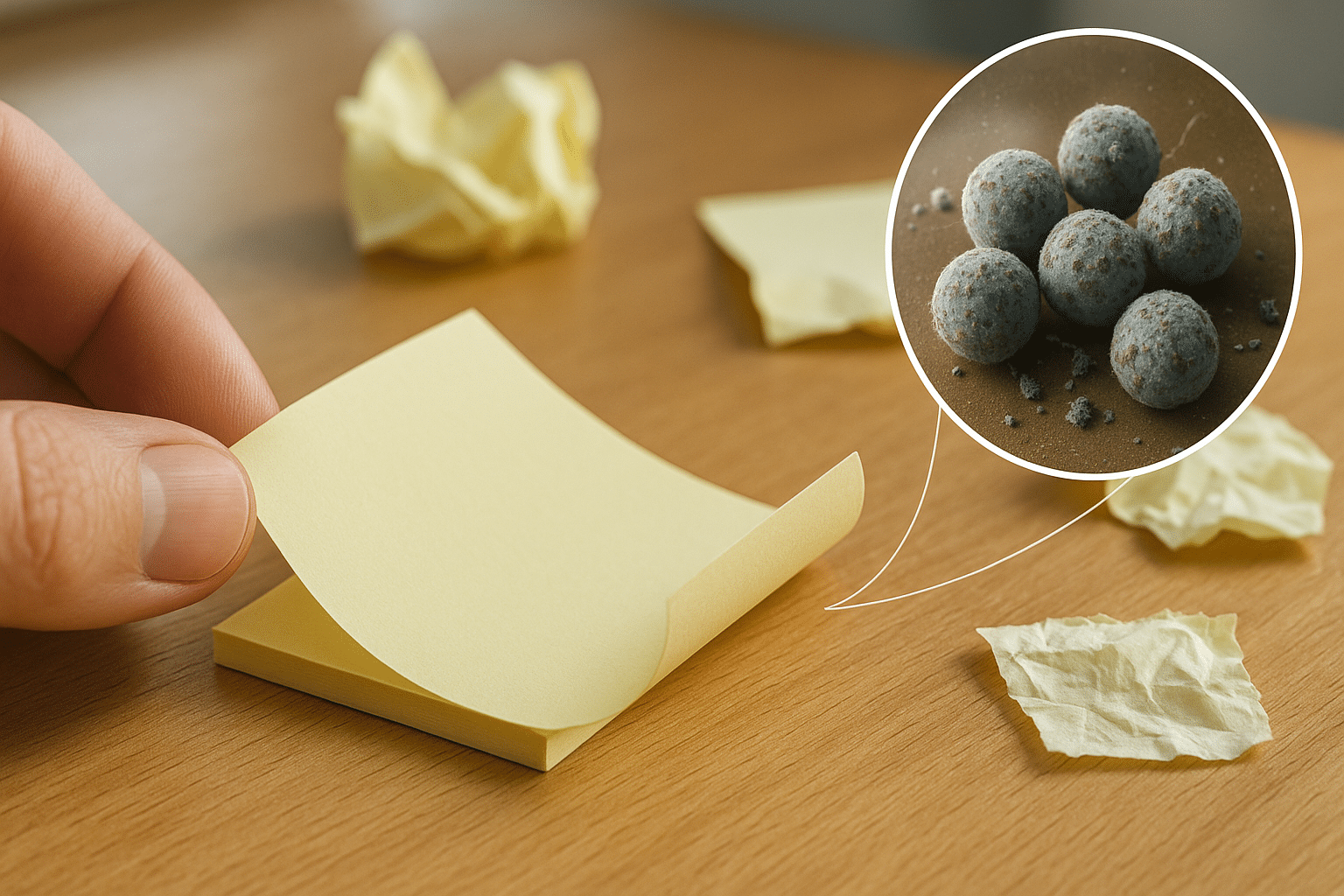
What Kind of Glue Do They Use on Sticky Notes? Surprising Facts
Discover the CLEVER ADHESIVE behind every STICKY NOTE. Learn what makes it REUSABLE, SAFE, and easy to PEEL—perfect for curious minds or DIY experiments.
Sticky notes are a staple in offices, schools, and homes, known for their light stick and easy removal. But what kind of glue gives them that balance? This article explains the specific adhesive used—how it works, what it’s made of, and why it performs differently than regular glue.
What adhesive is used on sticky notes?
Sticky notes use a water-based microsphere adhesive. These tiny acrylic spheres stick lightly to surfaces without leaving residue, allowing for easy removal and repositioning. This type of glue is pressure-sensitive, non-toxic, and specially designed to maintain stickiness over multiple uses without damaging paper or other surfaces.
What Makes Sticky Notes Stick Lightly
- Microsphere adhesive technology creates a low-tack, reusable bond.
- Water-based glue activates with light pressure, not heat.
- Round acrylic spheres prevent full surface contact.
- High-quality paper holds adhesive without tearing or bleeding.
- Coated backing ensures controlled glue spread and durability.
- Size and weight balance affects how well notes stay put.
- Clean, dry surfaces improve initial and lasting adhesion.

How Microsphere Adhesive Works
The glue on a sticky note isn’t your average school glue stick. It’s actually a clever adhesive made from tiny acrylic microspheres. These spheres don’t flatten out like other adhesives; they stay round, creating just enough tack to stick without clinging on for dear life. That’s what makes sticky notes so easy to move and reuse.
This microsphere adhesive is water-based and pressure-sensitive. That means it only activates when pressed lightly onto a surface—your desk, notebook, or even the fridge. No mess, no fuss. The magic lies in its low-tack nature: strong enough to hold a note, weak enough to peel away cleanly.
Most sticky notes, including the classic [Post-it note pads](https://www.viking-direct.co.uk/en/desktop-essentials-c-102/post-it-notes-sticky-notes-c-10208), rely on this unique glue formula. Brands like Elmer’s Products and Bostik don’t use it in glue sticks or tape because microspheres aren’t meant for permanent adhesion. They’re designed for the stick-and-move lifestyle of the humble sticky note.
Paper, Size, and Coating Factors
The type of paper used in a sticky note matters more than you’d think. It has to be smooth enough for the adhesive to grip but sturdy enough not to tear when peeled off. High-quality paper also prevents ink from bleeding through, whether you’re jotting notes with a pen or permanent marker.
Sticky notes come in different sizes, and size does affect function. A large note needs a wider glue strip to ensure it stays put on your desk or monitor. Coating also plays a role. A slight coating on the backing helps control glue spread, so it doesn’t soak through or weaken over time.
Manufacturers carefully balance paper weight, size, and adhesive pattern. It’s a dance of chemistry and engineering. Whether it’s a big bold square or a mini tab, every sticky note is built to stick where it should—and only where it should—without leaving a gluey mess behind.
Why Sticky Note Adhesion Changes Over Time
Ever pulled a sticky note off the pad only to watch it float gently to the floor five minutes later? That’s old glue talking. Over time, the microsphere adhesive can degrade. Exposure to air, dust, oils, and even humidity slowly chips away at its stickiness, making that once-loyal note more like a paper diva.
The surface it sticks to also matters. A smooth plastic desk may hold a sticky note better than a dusty monitor. Overuse—peeling and repositioning again and again—flattens the microspheres and weakens adhesion. It’s a bit like cling film that’s lost its cling. You can still use it, but it’s never quite the same.
To make your sticky notes last longer, store them in a cool, dry place. Avoid pressing too hard or leaving them stuck for weeks on the same backing. Repositionable doesn’t mean immortal—it just means forgiving for a little while. That’s the delicate charm of the sticky note’s adhesive life cycle.
| Feature | Description | Importance |
|---|---|---|
| Microsphere Adhesive | Water-based glue using tiny acrylic spheres for low tack. | High |
| Paper Quality | Ensures smooth writing, clean removal, and durability. | High |
| Note Size | Affects glue strip width and overall adhesion strength. | Medium |
| Coating on Backing | Controls glue application and prevents adhesive bleeding. | Medium |
| Surface Compatibility | Sticky notes perform differently on plastic, wood, or paper. | Medium |
| Environmental Exposure | Dust, humidity, and oils can degrade glue over time. | High |
Conclusion
Sticky notes might seem simple, but their glue is the result of clever design. With water-based microsphere adhesive, high-quality paper, and precise coating, they offer just the right level of adhesion—strong enough to stay put, gentle enough to remove cleanly.
At Viking, we understand the importance of smart, effective workplace tools. Whether you’re organising ideas or leaving reminders, [our selection of sticky notes](https://www.viking-direct.co.uk/en/desktop-essentials-c-102/post-it-notes-sticky-notes-c-10208) offers cost-effective solutions to support your productivity—without compromising on quality or environmental care.
Frequently Asked Questions
Is sticky note adhesive the same as regular glue?
No, sticky note adhesive is not the same as regular glue. It uses water-based microsphere technology that allows it to stick lightly to surfaces like your desk or notebook. Unlike a glue stick or tape, it doesn’t form a permanent bond and is designed to be easily repositionable without damaging the paper or surface.
Why don’t sticky notes lose their stick immediately?
Sticky notes use microsphere adhesive, which forms a light, pressure-sensitive bond. Because the spheres remain round, only a small part contacts the surface, allowing repeated sticking without full adhesion. If stored properly, sticky notes retain their stick for a long time, especially when kept free of dust and oils on the paper or backing.
Can I replicate sticky note glue at home?
Replicating sticky note glue at home is difficult. The microsphere adhesive used in products like Post-it notes is made through industrial processes not easily recreated with household materials. DIY versions often rely on rubber cement or diluted glue stick alternatives, but they won’t have the same clean removal or repositionable features.
Does sticky note glue stick to plastic surfaces?
Sticky note adhesive can stick to smooth plastic surfaces, but not always effectively. The low-tack microsphere glue is designed for paper, desks, and similar materials. Plastic can be too slick or dusty for a strong hold. Over time, the backing may curl, especially if the note is exposed to heat or moisture.




